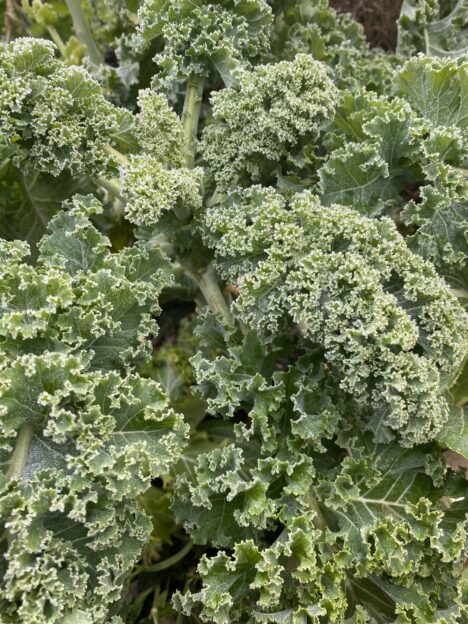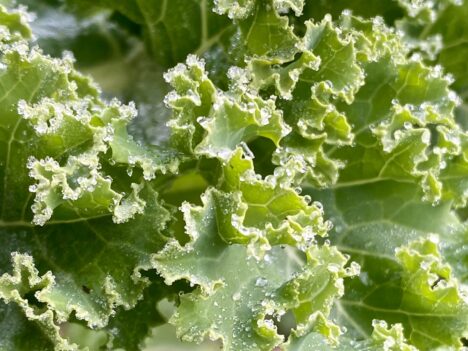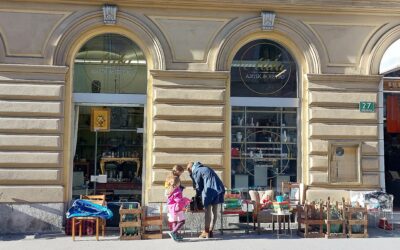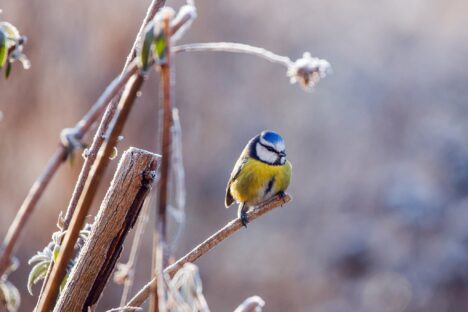Original post by Barbara Kochauf on January 24, 2023. Translated by Lisa Scheer in 2023/24.
Disclaimer: Some of the links in this post might redirect you to a site in German. Feel free to use Machine Translation (such as DeepL or Google Translate) to get the information provided on these sites.
Vitamins from our flower bed
Let’s think about and plan our garden. Collect ideas and hope to soon realise them. Perhaps we should do something new and put decorative vegetables into our flowerbed. There are a lot of attractive vegetables that could actually make your flowers jealous. Not only do they clean up every border, but they can also end up in your pan, but perhaps do not eat all their beautiful splendour straight away …
Chard
There’s the fairly uncomplicated chard and its particularly decorative variants with red and yellow stems. Its dark green leaves grow upwards to a height of 50 centimetres. You can harvest them continuously. It’s also lovely to look at in combination with yellow coneflower, zinnias or evening primroses. It can be left in the bed during winter and can be continously harvested. You will also have fresh vegetables on your plate in spring.
- Use: raw and cooked, like spinach, in salads and smoothies
- Cultivation: starting from April, put bigger plants into bed, or buy pre-cultivated plants, tolerates sun and partial shade.


Malabar spinach
The effective malabar spinach also belongs into your flowerbed. Make sure to give it climbing aids. The striking climber produces several metres of purple tendrils with dark green, roundish leaves. Later there will also be pink blossoms and dark purple berries. In the previous year, it wrapped around a pink rose in my garden – a beautiful combination. It loves the sun but is not hardy.
- Use: Shoot tips and leaves with corncob-like taste, can become bitter after blooming Can be eaten raw and steamed as spinach, add into your salad or into smoothies.
- Cultivation: Sow in April, not outdoors before the Ice Saints; or buy pre-cultivated plants.
- the berries can be used to dye or can be made into ink or paint.
Garden orache
A garden orache is a absolutely undemanding and also extremely decorative vegetable. Its reddish-violet leaves and its impressive height of up to 2 metres is a real eye-catcher in the flower bed. Once in your garden, it will resow itself with a lot of seeds – so, cut seed heads before they mature or reduce the small plants in spring.
- Use: raw or steamed, shoot tips and leaves, after flowers have formed they can become bitter; in smoothies, with your salad, in stir fry dishes or add to spinach
- Cultivation: sow starting in March, put bigger plants in bed, sunny to partial shade
Fragrant-flowered garlic
The next plant that adds nicely to the mix of flowers in the bed is the uncomplicated, resistant fragrant-flowered garlic which forms beautiful clusters. The long, narrow leaves with a garlic-like taste can be used to season dishes, salads, for bread spreads or for garlic salts. Don’t cut the leaves too close to the ground. Later there will be white blossoms on the thin, stable stalks that attract insects. During winter, it will retreat and will return in spring. Should you not want it to spread over your garden, cut off flowers before seed maturity because every seed could create a new plant.
- Use: leaves and blossoms, on top of bread, for bread spreads, soups, stir fry dishes, seasoned salt
- Cultivation: buy a pot with small plants, sun to partial shade
Sunflowers
Sunflowers generally are staples in flower beds, but it’s not commonly known that you can use the petals in various ways. On one hand, a handful of fresh leaves can be mixed into your salad, on the other hand it can be dried and can be added to tea in winter.
Artichokes
Artichokes also are impressive vegetable plants and insects love them. But they are capricious, they need enough water and enough space to properly flourish.
Wood dock
Wood dock (rumex sanguineus) offers dark green, long, lance-shaped leaves with bright red, strong veins. It also is resistant and sows itself sparingly. Works well as a border alternating with fragrant-flowered garlic.
- Use: raw or steamed, the slightly sour tasing leaves can be added to salads, smoothies or pestos and can be prepared with spinach
- Cultivation: If you don’t want to plant many at once, just buy a pot of wood dock. It doesn’t cost more than a packet of seeds.
Fennel
A delicately feathered tall vegetable plant is fennel, which really lets the bright colours of the flowers shine as a background. Its filigree flower umbels do not push themselves into the foreground either. You can differentiate between finocchio and fennel (harvest ripe fennel seeds, dry them and use them as fennel tea or spice). It can be light green or bronze and it is an ideal partner for roses.
Winter cress (barbarea vulgaris)
The winterproof winter cress can pass for a flower with its decorative, yellow flower umbels. If you leave it standing, winter cress will create seeds that bring out dark green leaf rosettes in autumn. You can already use its small flowers.
- Use: leaves have a slightly bitter taste and can be added to salads, bread spreads and smoothies
Brassica
Different kinds of extremely healthy subspecies of brassica are not particularly popular in Austria (while they are in northern Germany and in Italy). They are rich in minerals and vitamins, can be used in a multitude of ways, are tasty and decorative as well.
In our mixed bed, for example, the dark green palm kale fits very well; with its long, wrinkled leaves, it is a splendid appearance that certainly reminds one of a palm tree and can grow up to 80 centimetres high.
- Use: superfood during the cold months, raw or cooked, young leaves in salad and into finished soups, smoothies or stir fries; long leaves can be filled, infused with soup and be baked with cheese in the oven.
- leaves can be harvested all year around, plant in sunny spaces, favours compost
- Sowing: May to beginning June, easy to grow from seed
Another frost resistant species is kale which can be green or a beautiful violet. It fits nicely between flowers but it doesn’t like to be crowded by other plants. Its curly leaves remind me of a lush mop of hair, you should only harvest it in winter, the cold makes the leaves tastier.
- Use: small, tender leaves can be added raw into salads, cut away stems from larger leaves, stir fry tender leaves with garlic and olive oil, add to stir fries or to potatoes
- Sowing: starting mid-May, put larger plants into bed
To finish, another idea for a stunning visual: put a small handful of wheat or barley between flowers or perennials, tender stalks just look beautiful in your flower bed. Or bury a corn cob vertically – each corn will create a plant and a giant corn bush will appear.
Have fun with our ideas and let your ideas flower!
Sources:
- Wolfgang Palme: Ernte mich im Winter
- www.freudengarten.de
- Ute Bauer/ Wolfgang Hensel: Ganzjährig attraktive Beete
Picture credit: © Barbara Kochauf
Anmerkung der NiG-Redaktion:
Falls du keine wichtigen Beiträge oder Termine von uns verpassen willst, abonnier doch bitte gerne unseren Newsletter! Er kommt unregelmäßig und nicht zu häufig – versprochen. Oder schau regelmäßig in unseren Veranstaltungskalender.
Wenn dir gefällt, was wir auf dieser Plattform tun, nämlich bereits seit 2017 über Nachhaltigkeit, Umwelt- und Klimaschutz zu informieren, dann unterstütz uns doch bitte auch finanziell, um unsere Website in dieser Qualität und Fülle weiterführen zu können – uns hilft jeder Beitrag!
Verein „Nachhaltig in Graz“
BIC: STSPAT2GXXX
IBAN: AT20 2081 5000 4200 1552
Verwendungszweck: Spende/Sponsoring (Mehr zum Sponsoring hier)
Du kannst dir auch gerne unsere kostenlose App aufs Handy laden, damit kannst du Informationen, Veranstaltungen und vieles mehr entdecken: App Nachhaltig in Graz














